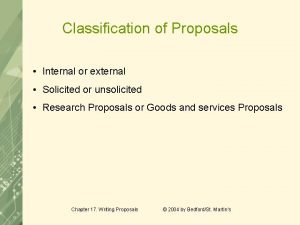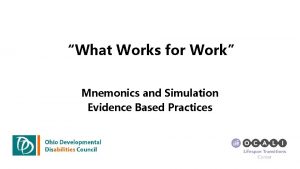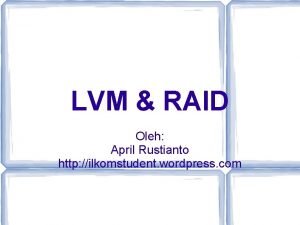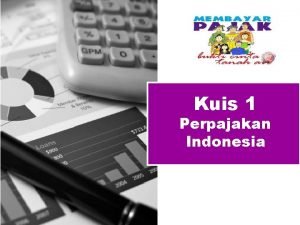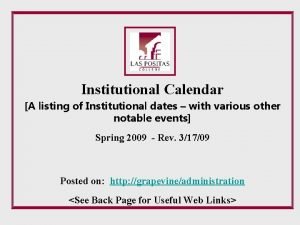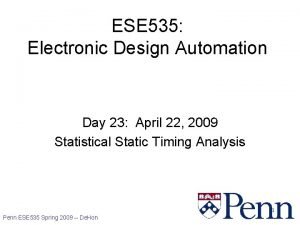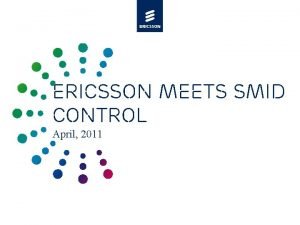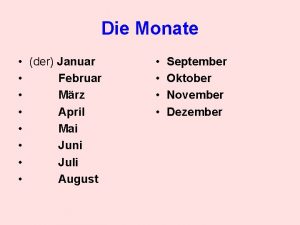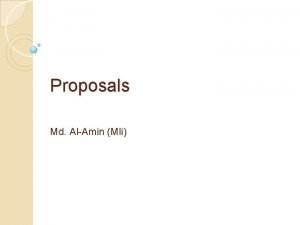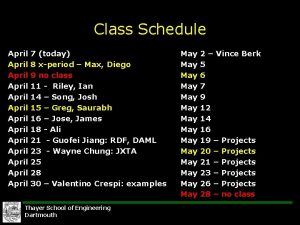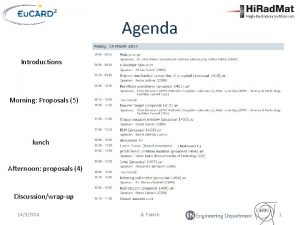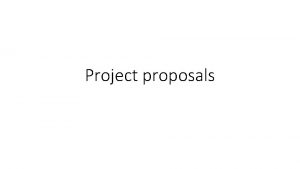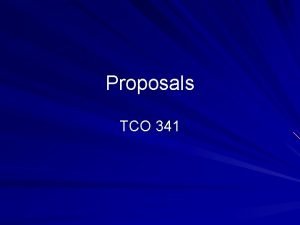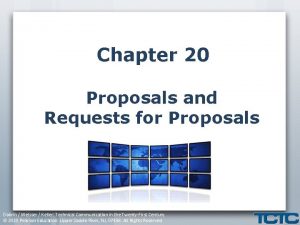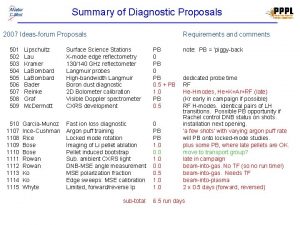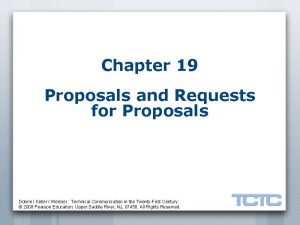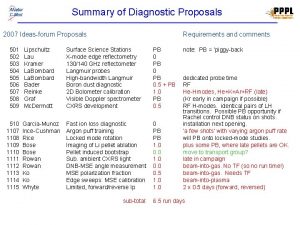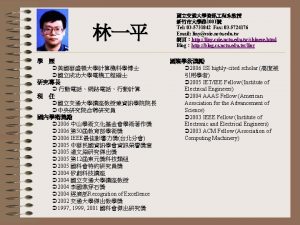Writing proposals April 19 2005 1 Writing proposals
































- Slides: 32

Writing proposals April 19, 2005 1

Writing proposals • The objective in writing a proposal is to describe what you will do, why it should be done, how you will do it and what you expect will result. Being clear about these things from the beginning will help you complete your research/paper in a timely fashion. • A vague, weak or fuzzy proposal can lead to a long, painful, and often unsuccessful writing exercise. • A clean, well thought-out, proposal forms the backbone for the research/paper itself. • Proposals help you estimate the size of a project. • The proposal must describes the problem that your project addresses 2

Real Example: Outsourcing of Information Technology: Future Adoption Plans of U. S. Corporations Dissertation Proposal Presentation Presented by: Rodney R. Yates Smith April 19, 2005 3

Summary of Presentation 1. Introduction 2. The Problem 2. 1. Background 2. 2. Purpose and Importance of Study 2. 3. Research Questions 3. Methodology 4. Projected Research Time-line 5. Conclusion 4

Discussing the Example An example of proposal presentation 1. Introduction (presentation introduction, not proposal introduction) Proposals issues -- in General research proposal 433 qualifications summarize the expertise of those who will conduct the research. You might also include their resumes in an appendix 2. The Problem 2. 1. Background ( of research problem) note: Literature Review; gives the factual background of the research, some time a proposal contain a literature review Background for the main aspect of the project describe the problem your research will address so that readers are confident that you understand the problem completely - Illustrate how much both your primary audience and others will benefit from the result of your proposed research. 5

Discussing the Example 2. 2. Purpose and proposal introduction Importance of Explain the reasons for and benefits of the Study proposal. -What the readers expect as a result of proposed research -What is the value of your potential finding Research plan (part 1) 2. 3. Research Questions focus on your research objectives, what specifically you plan to investigate 6

Discussing the Example Research plan (part 2) Methodology: how you plan to achieve your objectives (through interviewing? On the Web? Through other sources? Work Schedule 4. Projected Research Time-line outline realistic deadlines for specific research tasks that will help you achieve your objectives and meet the final deadline 3. Methodology 7

Discussing the Example Budget (if you want Budget funding) provide a list of projected cost for your research project, as appropriate, including cost f all resources needed to carry out your research plan Conclusion 5. Conclusion (for both – presentation - remind the reader of the benefits from and proposal) your research - and any specific products that will result, such as formal report. - Close with a request for approval by a specific date and offer to answer any of readers’ questions 8

1. Introduction • Professional Background • Interest in Outsourcing • Outsourcing Management Experiences – Market Research Corporation – On-line Advertising Corporation – ASP: Faith-based & Educational Organizations • Presenting & Researching 9

2. The Problem 1. Background A. B. C. D. Impact of Information Technology (IT) What is Outsourcing? Why Outsource? Kodak 1989 – Landmark Outsourcing Agreement i. Bandwagon Affect ii. Expectations - mixed results E. Risks of Outsourcing 2. Purpose and Importance of Study 3. Research Questions 10

2. The Problem, Background: Impact of IT • Large Budgets (Apte, Sobol, Hanaoka, et al. , 1997) • Improve corporate bottom line and competitive advantage (Ahles, 2003) • Expectations – Deliver projects on-time – Within or under budget – Without degradation of quality or service 11

2. The Problem, Background: What is Outsourcing? Definitions • Information Technology (IT): Computer technology (hardware & software) with telecommunications technology (data, image and voice networks) (Whitten et al. , 2004) 12

2. The Problem, Background: What is Outsourcing? Definitions • Outsourcing: – Transfer goods or service to a third party • Contract or selling • Hardware, software, communications network, systems, activities, processes, procedures and management • Third party: consulting firm, contractor or hardware vendor (Due 1992; Hirschheim and Lacity, 2002; Kern et al. , 2002; Lacity et al. , 1996; Loh and Venkataraman, 1992; Mc. Lellan and Marcolin, 1994; Quinn and Hilmer, 1994; Ramarapu, Parzinger and Lado, 1997; Takac, 1993; and Willcocks and Lacity, 1995) 13

2. The Problem, Background: What is Outsourcing? Definitions • Offshore (Global) Outsourcing: – Sending work to overseas locations (Marshall and Cohan, 2003) • Selective Outsourcing: – Outsourcing selected IT applications or functions to vendors while retaining other IT applications or functions in-house. (Lacity et al. , 1996) 14

2. The Problem, Background: Why Outsource? • Reduce Costs – 10% to 50% (Lacity and Hirschheim, 1994) • • Competitive advantage Increased service level Access to new technology and technical expertise Focus on core competencies (Lacity et al. , 1996; Udo, 2000) 15

2. The Problem, Background: Why Outsource? • Examples of Domestic Outsourcing: – Enron, Freeport-Mc. Moran, Continental Airlines, General Dynamics, National Car Rental and Continental Bank • Examples of Offshore (Global) Outsourcing: – Citibank, Texas Instruments, New York Life Insurance and Boeing (Shereff, 1989) 16

2. The Problem, Background: Landmark Outsourcing Agreement • 1989 Kodak – Total outsourcing of IT function – Anticipating a 50% cost savings – IBM, DEC and Businessland (Apte et al. , 1997; Earl, 1996; Lacity, 2002; Loh and Venkatraman, 1992) • Bandwagon affect: – 77. 1% U. S. companies outsourced domestically (Apte et al. , 1997) • Mixed results: – 48% early adopters (1984 – 1991) met their expectations – 51% did not meet or experienced mixed results (Apte et al. , 1997) 17

2. The Problem, Background: Risks of Outsourcing • • • Weak internal IT management Outsource vendor’s staff inexperienced Unclear future direction Outsource vendor’s skills remain current Inherent uncertainty of IT Hidden costs Lack of training Loss of innovation capacity Lack of IT and business communication Technology integration Unclear focus Earl (1996) 18

2. The Problem, Purpose and Importance of Study • Extend Sobol and Apte’s 1995 research: – – The extent of outsourcing being practiced ( )ﻣﺪﻯ ﺍﻧﺘﺸﺎﺭ ﺍﻟﻤﺰﺍﻭﻟﻪ The advantages and disadvantages of outsourcing Which functions or activities are appropriate for outsourcing Which hosting countries are appropriate for outsourcing • Provide additional empirical ( )ﺗﺠﺮﻳﺒﻲ evidence that supports selective global outsourcing – 30% - 60% cost savings potential (Ahles, 2003) 19

2. The Problem, Research Questions • Which IT functions are appropriate for global vs. domestic outsourcing? • Can corporations that enter into selective global outsourcing contractual agreements realize larger cost savings than corporations that enter into total domestic outsourcing agreements? • Can corporations that enter into selective global outsourcing agreements retain control over their technology options better than corporations that enter into total domestic outsourcing agreements? 20

2. The Problem, Research Questions - continued • Can technical employees who remain with a corporation that has a selective global outsourcing partner maintain or improve their technical skills? • Can corporations that have a selective global outsourcing partner control project schedules, or does the global outsourcing partner control the schedules? • What are the reasons given by companies for discontinuing domestic or global (offshore) outsourcing? 21

3. Methodology 1. Purpose and Objectives 2. Survey Methodology A. Survey Instrumentation B. Survey Testing 3. 4. 5. 6. 7. Target Population Selection of Subjects Respondent Data Preparation Survey Distribution Statistical Testing 22

3. Methodology: Purpose and Objectives • Demonstrate organizations utilizing selective outsourcing: – – Realize cost savings Control their technical environments Control their project schedules Employees maintain or improve their technical skills • Compare the experiences of 1995 most effective IS Users with my population, 10 years later. – Any significant differences in their outsourcing experiences? 23

3. Methodology: Survey Methodology • Self-administered Survey Questionnaire • Other IT Survey Studies – – – Downing, Field and Ritzman (2003) Elmuti (2003) Sandhill Group (2003) Apte et al. , (1997) Apte and Sobol (1995) 24

3. Methodology: Target Population • Outsourcing Strategies 2004: Global IT Outsourcing & Business Processing Outsourcing Forum – Centric Events Group – March 3 – 5, 2004, Las Vegas, NV – Strategy: Population of convenience and purposive 25

3. Methodology: Selection of Subjects • 209 out of 287 attendees • U. S. based organizations – 97% (204) U. S. based organizations – 3% (5) outside of U. S. – Disbursed throughout the U. S. 26

3. Methodology: Respondent Data Preparation • Titles of Respondent data( – )ﻋﻨﺎﻭﻳﻦ ﺍﻟﺒﻴﺎﻧﺎﺕ ﺍﻟﻤﺴﺘﺠﻴﺒﺔ 192 • Normalized titles( – )ﺍﻟﻌﻨﺎﻭﻳﻦ ﺍﻟﻄﺒﻴﻌﻴﻪ 10 – – – – – CEO CFO CIO COO Director Manager Other Partner President Vice President 27

3. Methodology: Selection of Subjects - Location 28

3. Methodology: Survey Distribution • U. S. Mail distribution: – – – Cover letter Informed Consent Agreement Survey Questionnaire Instrument $3 Starbucks gift card Eligible for raffle: one of two $50 Visa Gift Cards • Response Options: – Fax – U. S. Mail – Online: www. itoutsourcingsurvey. com Zhang (2000) 29

3. Methodology: Statistical Testing • Descriptive statistics – Describe patterns in the respondent database and response data • Analysis of Variance – Understand the influence of IV on DV • Discriminate Analysis – Determine the attributes or variables that differentiate the decision to outsource domestically or globally • Factor Analysis – Determine the impact or influence of one factor across other factors 30

4. Projected Research Time-Line • April 2005: IRB Application Process • May 2005: Data Collection • June 2005: Chapter 4: Results • July 2005: Chapter 5: Summary & Conclusions • August 2005: Dissertation Defense 31

5. Conclusion • Restate: benefits from your research and any specific products that will result. • Questions? • Comments? • Thank You!! 32
 Writing thesis and dissertation proposals
Writing thesis and dissertation proposals Writing and completing reports and proposals
Writing and completing reports and proposals Prefatory and supplementary part of proposal
Prefatory and supplementary part of proposal A business proposal chapter 10
A business proposal chapter 10 Artificial intelligence thesis proposals
Artificial intelligence thesis proposals Solicited external proposal
Solicited external proposal Elements of fire insurance contract
Elements of fire insurance contract When evaluating cost-cutting proposals
When evaluating cost-cutting proposals Developing effective research proposals
Developing effective research proposals Eclipse computing proposals slow
Eclipse computing proposals slow Delhi muslim proposals
Delhi muslim proposals April 23rd 1564
April 23rd 1564 23 abril 1616
23 abril 1616 30 days has september april june and november
30 days has september april june and november April school activities
April school activities April 26 1564
April 26 1564 April savoy allstate
April savoy allstate Sabbath day calendar
Sabbath day calendar Vårmåneder
Vårmåneder April rustianto
April rustianto Leonardo de vinci was born on april 15
Leonardo de vinci was born on april 15 Leonardo da vini
Leonardo da vini Reformdjp/quiz/kuis-mini-april
Reformdjp/quiz/kuis-mini-april Institutional calendar
Institutional calendar Guten morgen freitag 1 april
Guten morgen freitag 1 april April bjornsen
April bjornsen 1889 20 april
1889 20 april 535 days before 23 april
535 days before 23 april April ericsson
April ericsson Dreißig tage hat september
Dreißig tage hat september Januar februar märz april
Januar februar märz april April 26 1986
April 26 1986 Paula hurlock birthday
Paula hurlock birthday





